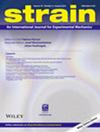Quantification of evolving moisture profiles in concrete samples subjected to temperature gradient by means of rapid neutron tomography: Influence of boundary conditions, hygro‐thermal loading history and spalling mitigation additives
IF 1.8
3区 材料科学
Q2 MATERIALS SCIENCE, CHARACTERIZATION & TESTING
引用次数: 5
Abstract
Concrete has a tendency to spall, that is, to eject layers when subjected to high temperatures. This is an erratic phenomenon, and our understanding of the underlying physical process is still limited. A driving process is moisture transfer, whose experimental investigation has so far mostly been limited to macroscopic or point‐wise observations, limiting both our understanding and the validation of the proposed models. In this paper, a non‐contact technique, neutron imaging, is used to extract a the full‐field distribution of moisture in 3D and in real time, while the concrete is heated at high temperatures. This reveals a number of processes often underestimated or ignored in the traditional experimental approaches reported in the literature. Notably, the effect on the evolving moisture profiles of varying heating rates for multiple insulation techniques as well the strong influence of the addition of spalling‐mitigating additives is presented. The first ever example of neutron tomography of a spalled sample is also reported, and some preliminary analyses of the effect that moisture clog formation and heating rates have on it are revealed.用快中子层析成像技术量化受温度梯度影响的混凝土样品中不断变化的水分剖面:边界条件、湿热加载历史和剥落减缓添加剂的影响
混凝土在高温下有剥落的倾向,即剥落层。这是一种不稳定的现象,我们对潜在的物理过程的理解仍然有限。一个驱动过程是水分转移,迄今为止,其实验研究大多局限于宏观或点上的观察,限制了我们对所提出模型的理解和验证。本文采用非接触式中子成像技术,在混凝土高温加热过程中,实时三维地提取混凝土中水分的全场分布。这揭示了在文献中报道的传统实验方法中经常被低估或忽视的一些过程。值得注意的是,不同加热速率对多种保温技术的水分分布的影响,以及添加减轻剥落添加剂的强烈影响。本文还报道了中子层析成像的第一个例子,并初步分析了湿气堵塞的形成和加热速率对它的影响。
本文章由计算机程序翻译,如有差异,请以英文原文为准。
求助全文
约1分钟内获得全文
求助全文
来源期刊

Strain
工程技术-材料科学:表征与测试
CiteScore
4.10
自引率
4.80%
发文量
27
期刊介绍:
Strain is an international journal that contains contributions from leading-edge research on the measurement of the mechanical behaviour of structures and systems. Strain only accepts contributions with sufficient novelty in the design, implementation, and/or validation of experimental methodologies to characterize materials, structures, and systems; i.e. contributions that are limited to the application of established methodologies are outside of the scope of the journal. The journal includes papers from all engineering disciplines that deal with material behaviour and degradation under load, structural design and measurement techniques. Although the thrust of the journal is experimental, numerical simulations and validation are included in the coverage.
Strain welcomes papers that deal with novel work in the following areas:
experimental techniques
non-destructive evaluation techniques
numerical analysis, simulation and validation
residual stress measurement techniques
design of composite structures and components
impact behaviour of materials and structures
signal and image processing
transducer and sensor design
structural health monitoring
biomechanics
extreme environment
micro- and nano-scale testing method.
 求助内容:
求助内容: 应助结果提醒方式:
应助结果提醒方式:


